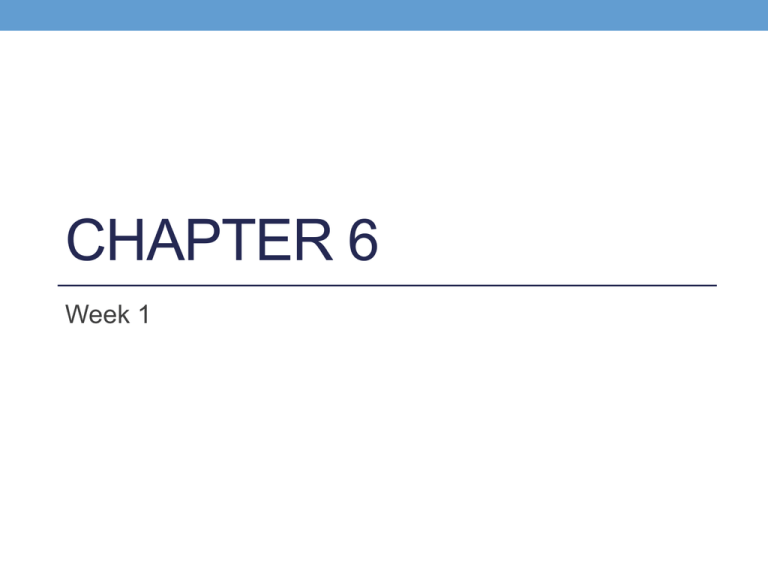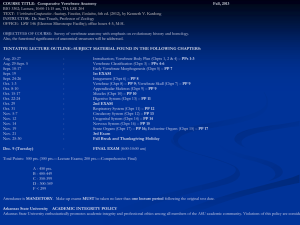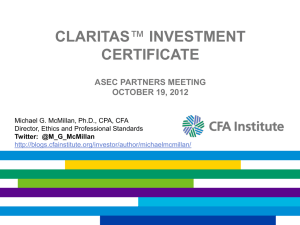Chapter 6 Week 2 Without Scoring Guide
advertisement

CHAPTER 6 Week 1 Homework for the Week • Monday 11/4 • Chpt 6 248-254 • Tuesday 11/5 • Chpt 6 255-261 • Prep for in class essay • Chapter 5 test corrections at lunch and after school • Wednesday 11/6 • Prep for in class essay • Chapter 5 test corrections at lunch and after school • Thursday 11/7 • Test review at lunch • Friday 11/8 • Chpt 7 264-267 Agenda: Monday 11/4 • • • • • • • • Chapter 5 Test Discussion Finish Optical Illusions 2nd Period - 9:45 am 4th Period – 11:35 am 6th Period – 1:55 pm Nov. 7th 1st Period – 8:10 am 5th Period – 1:20 pm • Monday 11/4 • Chpt 6 248-254 • Tuesday 11/5 • Chpt 6 255-261 • Prep for in class essay • Chapter 5 test corrections at lunch and after school • Wednesday 11/6 • Prep for in class essay • Chapter 5 test corrections at lunch and after school • Thursday 11/7 • Test review at lunch • Friday 11/8 • Chpt 7 264-267 Muller-Lyer Illusion: 1st Period Illusions provide good examples in understanding how perception is organized. Studying faulty perception is as important as studying other perceptual phenomena. Line AB is longer than line BC. Perceptual Organization: Grouping Principles Gestalt grouping principles are at work here. Perceptual Organization: Gestalt Grouping the perceptual tendency to organize stimuli into coherent groups Grouping Principles proximity--group nearby figures together similarity--group figures that are similar continuity--perceive continuous patterns closure--fill in gaps connectedness--spots, lines, and areas are seen as unit when connected Grouping After distinguishing the figure from the ground, our perception needs to organize the figure into a meaningful form using grouping rules. Law of Proximity The Law of Similarity The Law of Continuation Perceptual Organization: Closure Gestalt grouping principles are at work here. The Law of Closure Perceptual Organization Figure and Ground--organization of the visual field into objects (figures) that stand out from their surroundings (ground) Goblet or Faces? Faces or Vases? Perceptual Organization: Depth Perception Depth Perception ability to see objects in three dimensions allows us to judge distance http://www.youtube.com/watch?v=p6cqNhHrMJA Perceptual Organization: Depth Perception Illusory Depth Perceptual Organization: Depth Perception Illusory Depth Explanation Binocular Cues Convergence: Neuromuscular cues. When two eyes move inward (towards the nose) to see near objects and outward (away from the nose) to see faraway objects. Monocular Cues Relative Size: If two objects are similar in size, we perceive the one that casts a smaller retinal image to be farther away. Perceptual Organization: Depth Perception -- Relative Size Interposition closer object blocks distant object Interposition Relative clarity hazy object seen as more distant Perceptual Illusions Agenda: Monday 11/4 • Inspiration of the day: • http://www.youtube.com/watch?v=sbidTN9IyY&feature=youtu.be • Finish Illusions • The Five Senses Together • Activity Time! • Monday 11/4 • Chpt 6 248-254 • Tuesday 11/5 • Chpt 6 255-261 • Prep for in class essay • Chapter 5 test corrections at lunch and after school • Wednesday 11/6 • Prep for in class essay • Chapter 5 test corrections at lunch and after school • Thursday 11/7 • Test review at lunch • Friday 11/8 • Chpt 7 264-267 Monocular Cues Texture Gradient: Indistinct (fine) texture signals an increasing distance. Aerial Perspective Tall Arch Rick Friedman/ Black Star In this picture, the vertical dimension of the arch looks longer than the horizontal dimension. However, both are equal. Monocular Cues Relative motion: Objects closer to a fixation point move faster and in opposing direction to those objects that are farther away from a fixation point, moving slower and in the same direction. Monocular Cues Linear Perspective: Parallel lines, such as railroad tracks, appear to converge in the distance. The more the lines converge, the greater their perceived distance. Perceptual Organization: Depth Perception Perspective Techniques Linear Perspective Relative Brightness Light and Shadow: Nearby objects reflect more light into our eyes than more distant objects. Given two identical objects, the dimmer one appears to be farther away. In or Out? Motion Perception Motion Perception: Objects traveling towards us grow in size and those moving away shrink in size. The same is true when the observer moves to or from an object. Apparent Motion Phi Phenomenon: When lights flash at a certain speed they tend to present illusions of motion. Neon signs use this principle to create motion perception. lights to flashing one after the other. One light jumping from Two one point another: Illusion of motion. Video (first 1 min only): http://www.youtube.com/watch?v=urwAYd0XvGc The 5 Senses Together • http://www.ted.com/talks/jinsop_lee_design_for_all_5_senses.h tml • Activity: • Sit with a partner • Food Item #1: • Eyes open, Nose plugged, eat half. • Eyes open, Nose unplugged, eat second half. • Thoughts? • Food Item #2: • Eyes closed, Nose plugged, eat half. • Eyes closed, Nose unplugged, eat second half. • Thoughts? • Food Item #3: • • • • Eyes closed, Nose plugged, eat item. Eyes open, Nose plugged, eat second item. Eyes open, Noes unplugged, eat third item. Thoughts? (If time) Essay Prep #1 At a school wide rally preceding homecoming at Mountain View High School, each grade has a designated t-shirt color and seating area in the bleachers. Student leaders organize classes so that their colored shirts combine to form the school flag. The coach gives an exciting speech, the cheerleaders perform a routine, and the band plays the school song while the students sing in unison. • Explain the behavior and perceptions of the participants in the rally using the concepts below. Be sure to apply the concepts to the scenario in your explanation. • Cocktail party effect, Conformity, Deindividuation, Figure ground, Occipital lobe, Procedural memory, Sympathetic nervous system #2 Charlie is out in his yard playing baseball with his friends one sunny afternoon when a ball hits him in the knee. Discuss how each of the following components would affect Charlie’s sensation and/or perception of this experience: • Improper functioning of the visual system, Binocular depth cues, Attention, Reflexive reaction in the spinal cord, Gate-control theory of pain, Neurotransmitters, Sensory adaptation #3 A. The roots of varied states of consciousness – sleep, hypnosis, and the effects of drug use – have long been debated among theorists in psychology. Some argue that these varied states have cognitive or psychodynamic roots. Others argue the roots of these states lie in the biological mechanisms of the brain and nervous system. Discuss these alternate points of view regarding the causes/purposes of each of the following varied states of consciousness: Sleep and dreams, Hypnosis, The effects of psychoactive drugs • B. Discuss how the experimental process has been and/or is being used to explore the causes of any two of the above phenomena. Agenda: Block Day 11/6 & 11/7 • Teacher Evaluation Surveys: • Nov 6th • 2nd Period - 9:45 am • 4th Period – 11:35 am • 6th Period – 1:55 pm • Nov. 7th • 1st Period – 8:10 am • 5th Period – 1:20 pm • Essay General Considerations • In class essay: 25 Min • Grading Rubric • Monday 11/4 • Chpt 6 248-254 • Tuesday 11/5 • Chpt 6 255-261 • Prep for in class essay • Chapter 5 test corrections at lunch and after school • Wednesday 11/6 • Prep for in class essay • Chapter 5 test corrections at lunch and after school • Thursday 11/7 • Test review at lunch • Friday 11/8 • Chpt 7 264-267 Writing Instruction • On block day of next week you will be given one of three essay prompts to write on for 25 minutes. • Helpful hints: • Find the directive words: • Words like "identify," "describe," and "define" require straightforward definitions or examples that define the concepts. • Words like "explain," "analyze," and "discuss" require extended application of the information to the situations or contexts within the question. • Students should use different terms than those found in the question prompt to answer the question. Simply parroting the question's language is usually not a sufficient demonstration of a student's knowledge. • Use a separate paragraph for each concept addressed in the question. That will help readers find answers more efficiently. • Avoid lengthy introductions. It is not necessary to repeat the stem of the question. • Outlines cannot be graded. Stress that students should write in complete sentences and in paragraph form. • Your essay will be graded in class using a scoring rubric • Write in pen • Put your student ID # on the essay, NOT your name! General Considerations Answers must be presented in sentences, and sentences must be cogent enough for students’ meaning to be apparent. Spelling and grammatical mistakes do not reduce students’ scores, but spelling must be close enough so that the reader is convinced of the word intended. Within a point, students will not be penalized for misinformation unless it directly contradicts correct information that would otherwise have scored a point Students can score points only if information is presented in context. This means that they must clearly convey which part of the question is being answered. Throughout the essay, definitions alone without application are not sufficient to score points, but definitions can establish and/or enhance the context for the example. Because definitions alone do not score, if a student provides an incorrect definition but a correct application, score the point based on the application. Every point requires students to relate their answers to the scenario. 1. 2. 3. 4. 5. 6. 1. 7. For example, in prompt 1, the scenario is not limited to the pep rally. The application could include experiences related to the various participants or activities that occur before, during or after the pep rally (football game, practice, etc.). Context may be established by using words such as “student/students,” “participants,” “the event,” etc. Examples provided for each of the following points are not to be considered exhaustive. Prompt #1 • At a school wide rally preceding homecoming at Mountain View High School, each grade has a designated t-shirt color and seating area in the bleachers. Student leaders organize classes so that their colored shirts combine to form the school flag. The coach gives an exciting speech, the cheerleaders perform a routine, and the band plays the school song while the students sing in unison. • Explain the behavior and perceptions of the participants in the rally using the concepts below. Be sure to apply the concepts to the scenario in your explanation. • • • • • • • Cocktail party effect Conformity (pgs 560-562) Deindividuation (Pg. 568) Figure ground Occipital lobe Procedural memory (aka long term, implicit memory, pgs. 302 & 310) Sympathetic nervous system Prompt #2 • Charlie is out in his yard playing baseball with his friends one sunny afternoon when a ball hits him in the knee. Discuss how each of the following components would affect Charlie’s sensation and/or perception of this experience: • Improper functioning of the visual system • Binocular depth cues • Attention • Reflexive reaction in the spinal cord • Gate-control theory of pain (pg 250) • Neurotransmitters • Sensory adaptation Prompt #3 • A. The roots of varied states of consciousness – sleep, hypnosis, and the effects of drug use – have long been debated among theorists in psychology. Some argue that these varied states have cognitive or psychodynamic roots. Others argue the roots of these states lie in the biological mechanisms of the brain and nervous system. Discuss these alternate points of view regarding the causes/purposes of each of the following varied states of consciousness: • Sleep and dreams • Hypnosis • The effects of psychoactive drugs • B. Discuss how the experimental process has been and/or is being used to explore the causes of any two of the above phenomena. Agenda: Friday 11/8 • Chapter 6 Test • Monday 11/4 • Chpt 6 248-254 • Tuesday 11/5 • Chpt 6 255-261 • Prep for in class essay • Chapter 5 test corrections at lunch and after school • Wednesday 11/6 • Prep for in class essay • Chapter 5 test corrections at lunch and after school • Thursday 11/7 • Test review at lunch • Friday 11/8 • Chpt 7 264-267








